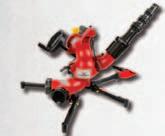





























































Florida Fire Service is the monthly publication of the Florida Fire Chiefs’ Association, provided to Florida Fire Chiefs’ Association (FFCA) members, by the Florida Fire Chiefs’ Association.
Florida Fire Chiefs’ Association
221 Pinewood Drive
Tallahassee, FL 32303
Phone:(850) 900-5180
Email: info@ffca.org • www.ffca.org
FFCA Staff
Ngoc Huynh- Executive Director
FFCA Board of Directors
Michael Choate - President
Trip Barrs - 1st Vice President
Ryan H. Crawford - 2nd Vice President
Harold Theus - Immediate Past President
Carlos Aviles - Secretary/Treasurer
Jeff Wagner - Northwest Region Director
Brady Rigdon - Northeast Region Director
Chuck Bogle - East Central Region Director
Chantal Botting - Southeast Region Director
Ian Kemp - West Central Region Director
Gregory DeWitt - Southwest Region Director
Ngoc Huynh- Executive Director
Cindy Morgan - Foundation Chair
Jeffrey Money - Senior Member

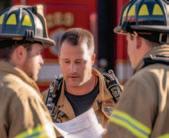
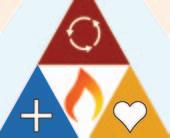
Broward Sheriff’s Office Welcomes Firefighter/Paramedic Classes
Competencies of
Tampa Fire Rescue Welcomes 38


Editorial Submissions magazine@ffca.org (850) 900-5180
Advertising
Scott Leisen, Editor in Chief scott@ffca.org (386) 717-0055
Subscription rate for members is $36, which is included in member dues. Archived electronic monthly editions of Florida Fire Service magazine are available at www.ffca.org. Log in as a member and click on the Publications tab.
Florida Fire Service
June 2025, Volume 33, Number 6 USPS # 016-759
Periodical postage paid in Daytona Beach, Florida, and additional post offices.
POSTMASTER: Send address changes to Florida Fire Service, 221 Pinewood Drive Tallahassee, FL 32303. Statements of fact and opinion are the responsibility of the authors alone and do not imply an opinion on the part of the officers or the members of FFCA. Copyright 2025 by the Florida Fire Chiefs’ Association. All rights reserved. Materials may not be reproduced without written permission.
Guns and Hoses Hockey
Department Launches
Sarasota County: A Heart


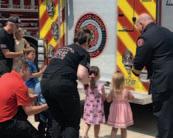





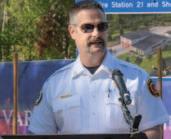




























Greetings to you all;
This month marked the end of our “regional meeting season.” I had the honor of addressing our members at the First There First Care Conference, held at the Seminole Hard Rock Hotel & Casino in Hollywood. This meeting was very well attended and wrapped up our tour across the state, where I along with your regional directors were able to engaged directly with each of you in every region—learning from local challenges, sharing updates from our association and reinforcing our collective mission.
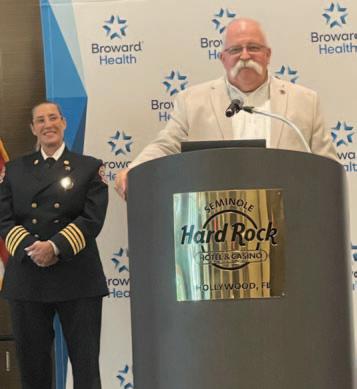
Southeast Regional Meeting
As the First There First Care Conference closed our regional meeting season, I want to commend every chief who participated in our regional sessions and legislative outreach. Our unity is glaringly evident and I as your president appreciate all of you very much!
Our legislative team, in close coordination with our partners at the Florida Fire Marshals and Inspectors Association (FFMIA), the Florida Professional Firefighters (FPF), and the Division of the State Fire Marshal, monitored a wide range of legislation throughout this year’s session. However, no bill garnered more attention—or sparked
more intense debate—than House Bill 929.
During a recent meeting with Florida’s Independent Fire District Chiefs, HB 929 was at the forefront of our discussions. The conversations were passionate, and the level of concern expressed was significant. Chiefs voiced serious apprehensions about the farreaching implications of the bill, particularly its impact on firefighter protective equipment standards and the operational challenges posed by the proposed 42-hour workweek guidance.
That said, I thought I would share a few highlights.

“clean” gear will require careful financial planning by us all. We should begin inventory audits and procurement strategies now.
It is important for all of us to come together with a unified message to ensure we are properly informing our firefighting staff and comply with this mandate.
• 42Hour Standard Work Week: While not a mandatory cap, HB 929 strongly encourages limiting normal firefighter workweeks to 42 hours to reduce burnout. Adapting to a 42hour workweek may require staffing shifts, potentially necessitating additional hires or schedule redesigns to ensure readiness and compliance.

On June 5, 2025, Governor DeSantis signed House Bill 929 during the Florida Professional Firefighters Convention in Palm Beach Gardens. First and foremost, congratulations to our brothers and sisters at the FPF. This was their most passionate bill concerning our firefighter’s mental health and wellbeing. The bill will take effect July 1, 2025.
• Mental Health & Suicide Monitoring: The State Fire Marshal’s Division must adopt rules for mental health best practices, suicide prevention, and monitoring. This is great legislation for us all. The division is passionate about this and will hit the ground running. This section of the bill underscores our commitment to firefighter welfare— promoting mental health resources, suicide prevention, and safer working environments.
• Protective Gear Safety: Departments must phase in turnout gear free from hazardous chemicals once available commercially. Firefighters must also be informed if existing gear contains toxic substances. Transitioning to PFAS-free or
This is only encouraged. Remember that a fiscal impact study has to happen and go back to the house and senate for visibility as part of the rule making process. The state constitution dictates impact bargaining with our labor force. I would encourage all of you to start having these conversations now with your leadership and your collective bargaining group.
I know I keep reiterating this, however… HB 929’s passage is simply an example and highlights how crucial it is for all of you to build direct ties with your state lawmakers. A single conversation with your representative or senator can make a big difference in shaping laws that protect our firefighters and our communities. Local advocacy ensures our voices resonate in Tallahassee—and beyond.
Stay Safe, With Others in Mind.
Michael J. Choate
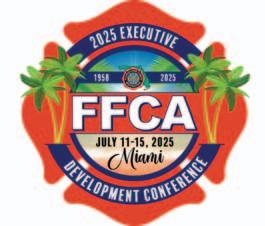










By Rick Spence
At the time I am writing this article, the social unrest that originated in Los Angeles has spread throughout the nation, Iran and Israel are both heavily bombing each other, and a man in Minnesota shot and killed two legislators and injured several others. This was the 184th shooting in our country in 2025, that met law enforcement’s criteria for Mass Shooting (4 or more injuries/casualties in one incident). The first thing that jumps out at me is that there is something evil that causes an immense hatred of people with different values and beliefs. It is one issue to disagree with others, it is a totally different issue to despise them enough to want to cause physical harm to them because of their beliefs, whether they are political, spiritual, economic or social beliefs.
Firefighters have strong opinions on the issues I mentioned, but for the most part, they rarely involve themselves in public protests. But that does not mean they hold a lesser view of their own beliefs. Maybe they have a more rational way of looking at the things going on in the world (like an incident size up) and realize there are no simple answers for a lot of the world’s problems. That is my perspective, coming from an old school firefighter in a new age world. There once was a time when the worst disagreements in the station were over such delicate topics as who controlled the TV remote and the proper way to load a
dishwasher. As society has changed and our workforce has gotten younger and more diverse (both positive advances), there is a tendency to discuss these issues more frequently in the fire stations.
What I have learned, after years of thinking everyone should be entitled to my opinion, is that not everyone thinks the same as me. Just because their views are different, it does not mean they are wrong, just different. I tended to take it as a personal slight if someone did not have the same opinion on an issue as I did. That was the wrong way to look at the situation. Their upbringing, education and the significant life events shaped their values differently than mine. This is something I should have realized by living in a fire station with them over the years. I often realize that I thought everyone around me shared the same opinions and beliefs that I did. It sounds like I was a millennial way before it was considered trendy
But the most difficult lesson that I learned was that when I spoke in favor of my values, I was speaking against someone who did not share those values. This was something that should be heart breaking for a Christian man to do. WWJD!! (What Would Jesus Do) quickly pops into my head. I’m pretty sure that was not what I was doing. Throughout the New Testament, Jesus interacted with every type of person: prostitutes, thieves, poor people,
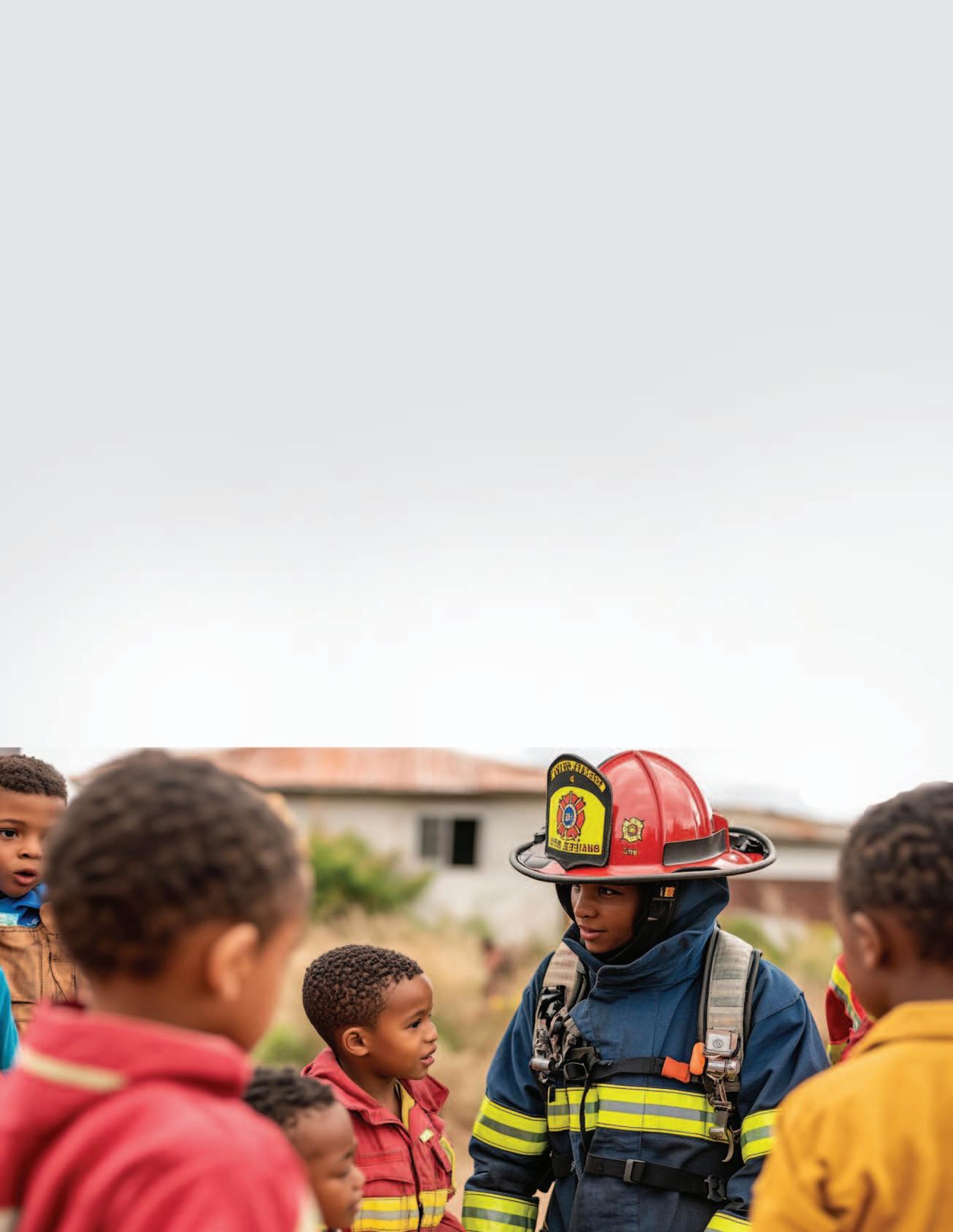
wealthy people, the sick and outcast of society, the powerful and the lowly, as well as, political and religious leaders. Of all these people, the only ones Jesus was critical of were the religious leaders of the time. It was because they were hypocrites in the way they enforced laws and traditions on their people in the Temple. Of the other people He interacted with, not all of them followed Him or believed He was the Messiah. But He did not treat them any differently than those who chose to follow Him. He healed them, taught them, fed them and cared for them as if they were also one of His disciples. He made them feel valued and included, even if they believed differently than Him. That is how I should have handled my situation in the fire station. There is a verse in the Old Testament that sums this up. This verse has made such an impression on me that I have taken it as my life verse. Micah 6:8. “What does the Lord require of you? To love justice, do kindness and walk humbly with the Lord.” Dang!! If I had only followed this verse 20+ years ago, my life would have been so much easier
Rick Spence retired as Assistant Chief from the Reedy Creek Fire Department after 30 years. He was selected Florida Professional Firefighter of the Year in 2018. He has been married to his wife Alecia for over 30 years




The Emergency Service Leadership Institute (ESLI) successfully hosted its Finance and Budget Module on May 13-14 at Valencia College, drawing 31 fire service professionals from across the state. This comprehensive two-day course brought together mid-level supervisors through the rank of Fire Chief, all focused on
strengthening their leadership capacity in the crucial areas of fiscal responsibility and financial management. In addition to classroom instruction, the course highlighted emerging opportunities for resource funding, including grants and partnerships, which are critical for departments facing budget constraints.
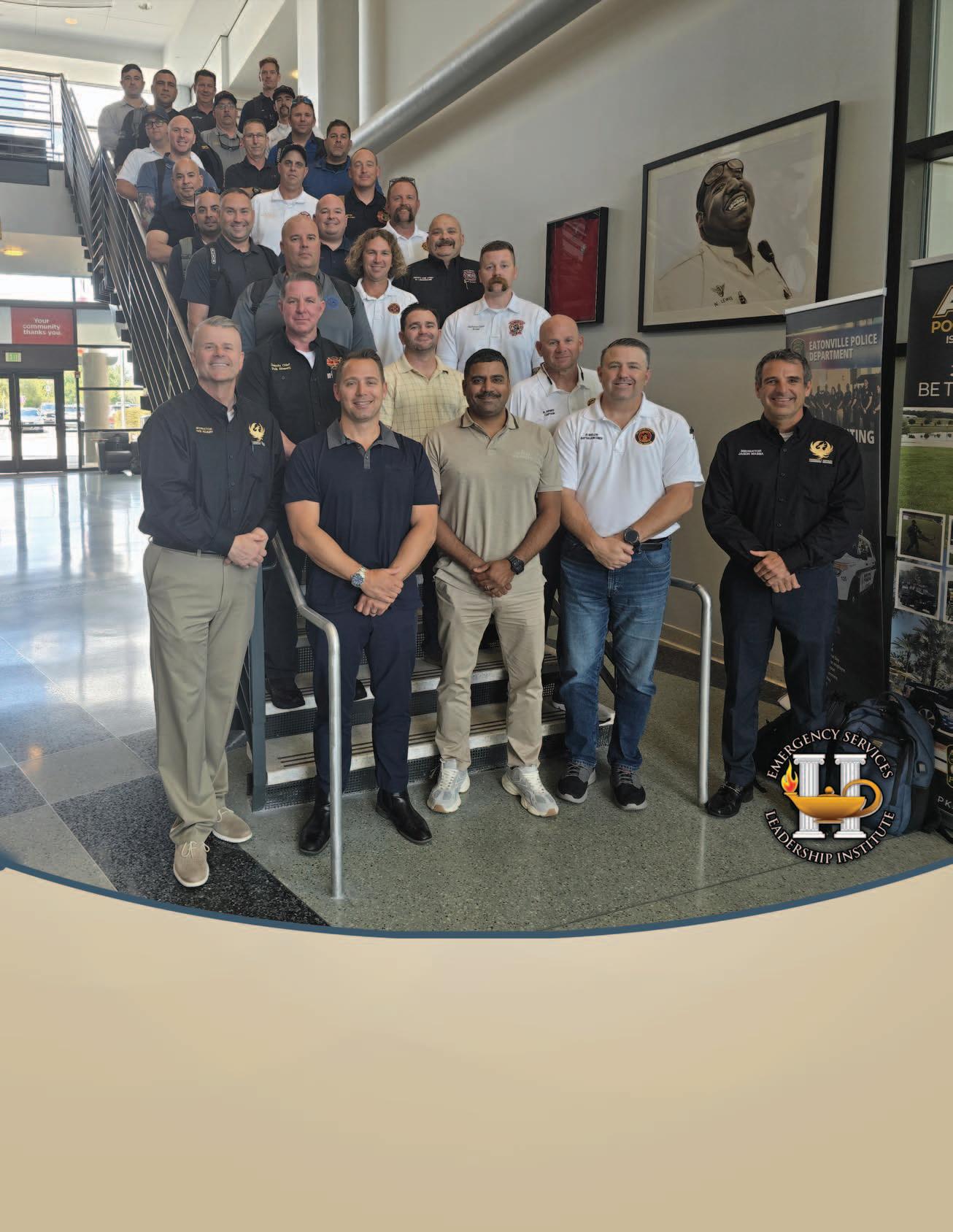
Performance measurement was also a focal point, equipping participants with strategies to track financial efficiency and justify budget requests with data-driven results for improved deliver y services.
Instructors: Public Safety Director David Kilbury (Lake County Fire) and Division Chief Jason Massa (Sunrise Fire Rescue).


By Joseph Dorsette, Assistant Chief of Specialized Services, Broward Sheriff’s Office Department of Fire Rescue
The Broward Sheriff ’ s Office Department of Fire Rescue proudly welcomes 27 newly hired cross-certified firefighter/paramedics. These two cohorts are set to begin a comprehensive 10-week

training program designed to enhance their knowledge, skills, and abilities in both firefighting and emergency medical ser vices.
We are excited to support these new team
members as they embark on a challenging and rewarding journey in public ser vice. Their dedication marks the beginning of a meaningful career committed to protecting and ser ving our community.

By Lexipol Team
Firefighters are hired and trained to respond under pressure, often making life-or-death decisions in chaotic environments. But what about the ethical decisions that come with the job? What happens when doing the right thing isn’t as clear-cut as choosing the right fitting for a hose and hydrant?
In the Lexipol webinar, “Why Good People Make Bad Decisions: Ethical Decision Making in the Fire Service, ” Chief Kris Blume and Susie Zavala, LMSW, offer thought-provoking observations about the real-world ethical dilemmas facing the fire service today. Drawing on clinical insight and personal experience, they challenge firefighters and fire service leaders alike to examine how stress, culture and organizational dynamics can shape ethical choices.
Here are five key points from the webinar that underscore how vital ethics training and moral awareness are to fire service leadership.
We often think of ethics as a personal trait — you either have integrity or you don’t. But Chief Blume and Zavala push back on this simplistic view Ethical decision making, they argue, is
strongly influenced by external factors: the situation, the system and the organizational culture.
“Most of us make questionable calls based off of the reward of silence,” Zavala says. That silence comes from systems that prioritize conformity and obedience over curiosity and questioning.
“Ethics is not a decision between right and wrong,” Blume adds. “It’s often a decision between right and right.”
Ultimately, leadership must recognize how organizational norms influence decision making,
If you’ve never heard the term “moral injury,” you’re not alone. But the concept should be at the forefront of every leader’s mind. Moral injury refers to the emotional, psychological and even spiritual distress that arises when someone engages in (or witnesses) actions that go against their core values.
Zavala explains: “This is not a diagnosis... This is more like death by a thousand paper cuts.” She goes on to describe how firefighters often come into the profession with high ideals
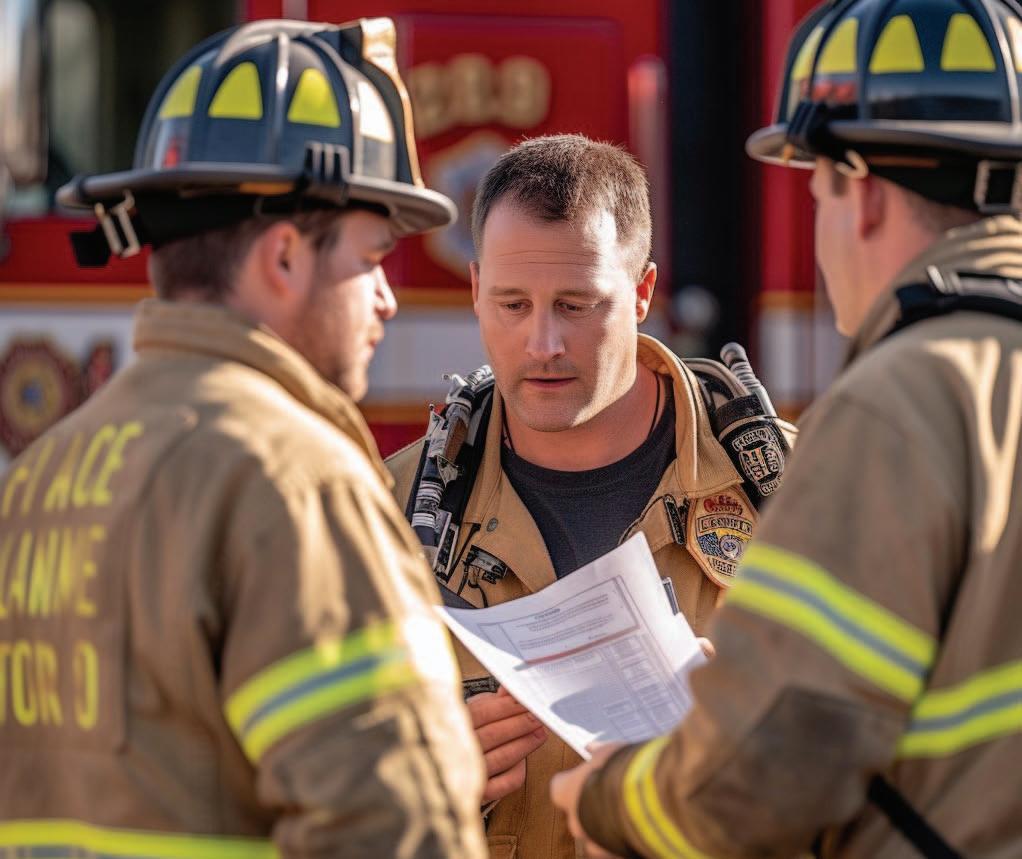
to save lives, protect communities and serve honorably. But over time, they may find themselves navigating broken systems (like behavioral health or child welfare) in situations where their actions fall short of their expectations. That dissonance takes a toll.
“The telltale signs are guilt, shame, loss of identity, and spiritual distress,” Zavala says. And leadership is not immune. “I also see leaders who have to make decisions that go against their own morals because they are required by policy.”
One of the webinar’s most useful frameworks is the idea that ethical decision making happens across three domains: individual, situational and systemic.
Chief Blume underscores this point as he discusses the vulnerability gap — the space between stimulus and response. “This is where we either act on instinct or take a moment to think,” he says. “That gap is where ethics lives.”
The presenters explore how stress, fatigue, lack of information or peer pressure can compress this gap and push people into flawed decisions. They point to famous psychology experiments like the Milgram and Stanford Prison experiments to show how ordinary people can drift into unethical behavior when the system rewards obedience or conformity.
Put bluntly: “People don’t just jump to unethical behavior,” says Zavala. “They inch toward it. One compromised decision, one silence, one shortcut.”
The fix? Leaders must create an environment of psychological safety where it’s okay to speak up, ask questions and admit mistakes.
Too often, agencies only get around to talking about ethics in the aftermath of failure. Whether individual or agency-wide, these kinds of breakdowns are apt to prompt conversations about right and wrong. But ethics should be an integral part of daily operations, not just disciplinary action.
Chief Blume says it best: “Discipline is not about the big decisions. It’s how we consistently apply values to the small things.”
From the condition of the firehouse to how new recruits are treated, culture communicates what’s acceptable and what’s not. Public safety
leaders of all stripes need to enforce expectations consistently and lead by example.
Zavala recommends incorporating ethics into debriefs, hot washes and after-action reviews: “Instead of focusing just on tactics and performance, ask: Were we aligned with our values during this incident?”
Leaders also need to model vulnerability. As Blume points out, “Leadership is the hub that influences discipline, cohesion, culture and education. It doesn’t matter what rank you hold. Everyone has the power to lead ethically.”
One of the most important things to learn about ethical judgment is that it doesn’t happen in a vacuum. It requires practice, exposure and conversation.
“Training is about preparing before that moment of decision,” Blume says. “It allows us to develop judgment and activate our intuition.”
Zavala adds that ethical preparedness should be baked into every part of training, not limited to annual “check the box” compliance courses. One simple way to do this is to include ethics questions in every training scenario. Reflect not just on what was done, but why.
“An easy way people can integrate this is during a debrief. Instead of focusing just on the tactical,” Zavala adds, “focus on the judgment, the ethics, the emotional toll.”
Firefighters are trained to size up a structure, understand the physics and act quickly but with deliberate intent. But ethical decision making requires just as much training and just as much intention.
As Chief Blume and Susie Zavala make clear, ethical drift doesn’t happen because people are bad. It happens because the job is hard, the systems are imperfect and the stress is constant.
Leaders at all levels must foster a culture that brings ethics out of the shadows and into daily operations. That means:
•Prioritizing psychological safety
•Encouraging open dialogue about tough decisions
•Modeling vulnerability and accountability
• Integrating ethics into every level of training
“Give yourself grace,” Zavala urges, “and don’t suffer alone.”
Ethical strength is like any other kind of strength in the fire service — it’s built through repetition, reflection, and the willingness to confront the hard stuff together.

By Dr Eric Smith, EFO, Assistant Professor of Public Administration, Barry University
Over the years, much thought has gone into what makes a successful leader. Do those persons recognized as leaders have some special genetic quality not possessed by the rest of us, or are their leadership skills a result of their environment? And what core competencies do successful leaders share?
Although there is no empirical scientific evidence supporting a genetic predisposition to leadership, there is evidence that a person’s environment can contribute strongly to developing leadership potential. Environmental conditions such as mentoring by positive role models and involvement in programs designed to teach life skills can be invaluable in creating leadership potential.
It is reasonable to say that potential leaders will possess a certain number of competencies that would indicate their fitness for a leadership position. The United States Army’s Army Leadership Requirements Model mentions several competencies required of an Army leader
A leader of character:
• Possesses Army values
• Has empathy for others
• Has a warrior ethos
A leader with presence:
• Has military bearing
• Is physically fit
• Is composed and confident
• Is resilient
A leader with intellectual capacity:
• Has mental agility
• Uses Sound judgment
• Able to develop innovative ideas

• Leads others
• Extends leadership beyond chain of command
• Leads by example
• Communicates Develops:
• Creates a positive environment
• Prepares self
• Develops others
• Gets results
It is certainly not a stretch to compare and contrast the Army model with fire service leadership needs. In his Master’s thesis, Lieutenant Scott Chappell of Marion County Fire Rescue conducted survey research to identify, compare, and contrast the traits that survey respondents deemed to be the core competencies of leadership. Lieutenant Chappell’s research identified the three highest rated competencies of leadership as seen by fire service professionals. The three highest rated were: (1) Trustworthy; (2) Accountable; (3) Honorable.
Conversely, the three most important leadership competencies according to the civilian survey respondents were: (1) Accountability; (2) Trustworthiness; (3) Communication skills. The research showed evidence that the civilian population and fire service professionals were very much alike in what they think makes a good leader.
In reviewing the Army leadership model and comparing it to the fire service and civilian respondents, it can be argued that accountability, trustworthiness, and character are synonymous. We all to want leaders who we can trust and who we feel are going to hold themselves accountable for providing us with strong leadership.
Due to the unique nature and paramilitary tradition of the fire service, it is no surprise that fire
service respondents selected honorable high so high on their response list. This response fits nicely with the fire service tradition of self sacrifice and honorable actions. It is also no surprise that civilian professionals and the fire service professionals diverged on the importance of communication.
Although civilian respondents selected communication higher in rank order than fire service respondents, it cannot be inferred that communication holds no value for the fire service. Civilian professional’s work schedules are normally defined by an eight hour day with no further job contact once that eight hour time frame has concluded. In that particular workday configuration opportunities for communication are limited, however, opportunities for the troubles brought on by a lack of communication are often multiplied in the limited amount of daily work time. Most certainly, the fire service is not immune from organizational communication problems, but the fire service and the military require around the clock operations. This never ending operational loop, coupled with the criticality of the mission and a healthy, functioning chain of command can keep organizational communication problems to a minimum. In the past, many have looked upon management as a science and leadership as an art form. However, social scientists have come to realize that leadership is just as much of a science as management, and therefore should be studied in order to develop models to create successful organizational leaders. By identifying your organization’s core leadership competencies you can put science to work by instilling these leadership competencies in your present and future leaders.


By Doug McGlynn
Over the past 30 years, I’ve had many proud moments in the fire service, but none beat seeing my youngest son join the ranks of our department earlier this year
He grew up hanging off the rails of apparatus, walking in parades, and spending more time in the firehouse than on the playground. By the time he hit high school and spent years as a fire cadet, we both knew that his love affair with the fire department had become much more than a childhood obsession. As a young man, it was clear that he wanted the fire service as a career, and that he was ready to answer the calling.
He asked, “Dad,doyouthinkIhavewhatit takes?”
I told him how he’d been raised on the same ‘3” things I’ve relied on my whole career: Heart, Habit, and Attitude.” It wasn’t until this time that I realized these three factors were very much akin to the core elements of fire itself: Fuel, Heat, and Oxygen. I had always been drawn to people who had that internal fire inside them, that enthusiasm for life that seemed to be contagious. It was hard to describe, but I knew it was more than just passion and energy. Those fire service leaders, instructors, and mentors of mine seemed to have a fire in their bellies that could not be

extinguished. I explained how I strived to cultivate that in my own life, and in turn, I had passed it down to him. Over time, I began to see a pattern and a sequence emerge in HeartHabit-Attitude and realized how the trifecta related to the Fire Tetrahedron.
We know that fire can’t exist without fuel, heat, and oxygen. There are rare exceptions involving chemical compounds and oxidizers, but generally speaking, remove one element and the fire dies. I believe the same is true for a person’s internal fire. Heart, Habit, and Attitude are essential—take one away, and your fire starts to fade.
That belief led me to explore the true point of origin in leadership development. I wanted to understand what ignited the fire in the belly of the leaders I respected—and, more importantly, how they kept it burning without burning out. I found the answer in those same three elements: heart, habit, and attitude. Heart is character. It’s the point of origin and the fuel source of who you are. It’s the depth of conviction, purpose, and integrity that drives everything else. People often say, “Oneof thesaddestthingsinlifeiswastedtalent.” I disagree. What truly disappoints is someone who lacks heart.
What comes from the body—your effort,
your choices, your leadership—flows from the heart. If the heart isn’t right, nothing else will be.
Investing in what matters starts by strengthening your own heart: becoming the kind of person others can count on, and showing up with presence and purpose for those around you. I was taught early to give my heart fully to whatever I was doing. But I also learned this: you can’t pour from an empty tank. You have to invest in your character and build up that foundation first.
In the fire service, we understand the weight of this truth: get your heart right before you put on your helmet.
Too many people are trying to join our ranks for the wrong reasons—steady pay, pension, benefits, or time off. Those things aren’t bad, but they shouldn’t be the reason someone applies to your agency.
Habit is repeated behavior and effort. It’s the heat required to produce and sustain a flame. A heart without habit is like fuel without a spark—there’s potential, but no ignition.
Plenty of people have heart, talent, and passion, but they’re unwilling to do the work. We live in a culture addicted to instant gratification. Reward is glorified, but effort? That gets ignored, mocked, or worse— demonized.
Don’t believe it? Just turn on the TV. Count the get-rich-quick schemes, miracle weight-loss solutions, and shortcuts being sold. Going to the gym, putting in the reps—that’s too slow, too boring. It’s pain now, reward later. Our culture is wired for the opposite: pleasure now, even if it brings pain later.
That mindset is fueling a generation of addiction—dopamine hits from social media likes, gambling, pornography, drinking, or drugs. The problem isn’t just addiction to substances. It’s an addiction to shortcuts.
But here’s the truth: dopamine also fires when you build discipline. Small wins, stacked daily, begin to reshape your brain and your behavior. James Clear put it plainly in Atomic Habits: “You don’t rise to the level of your goals. You fall to the level of your systems.”
Systems built on discipline, repetition, and purpose generate heat.
And heat sustains the fire long after motivation burns out.
The truth is, heat requires effort, which is exactly why most people avoid it.
Then, they wonder why they’re ice cold, stuck, or burned out before they ever got started.
+ ATTITUDE IS OXYGEN (O2): In fire and in life, oxygen is non-negotiable. In high-O2 environments, fire intensifies. In low-O? condi-

tions, it dies out. Attitude works the same way. A fresh, positive attitude feeds momentum and fans the flames. A negative one drains the energy in a room, stifles progress, and suffocates those around. Ever experience how one negative person can literally suck the oxygen out of a room? In leadership, your attitude doesn’t just affect your fire—it affects everyone near it.
Oxygen, like attitude, doesn’t operate in isolation—it reflects the atmosphere it lives in. Step into a room filled with encouragement, accountability, and passion, and it’s like entering an oxygen-enriched environment: everything burns brighter. But step into a space dominated by cynicism and negativity, and you’ll find one of the most toxic and unproductive work environments you’ll ever experience.
Even more dangerous is the oxygendepleting negativity we silently rehearse in our own minds. Craig Groeschel writes in Winning the War in Your Mind, “Your life is always moving in the direction of your strongest thoughts.”
If those internal narratives are negative, selfdefeating, or full of doubt, they’ll quietly suffocate your growth from the inside out— long before your environment ever does.
Heart, Habit, and a positive Attitude— remove any one, and your leadership can’t sustain for very long.
Just like fire needs fuel, heat, and oxygen, leadership demands the same.
Over the years, I’ve seen three common leadership profiles emerge—each reflecting a stage in fire behavior. We see them in our stations, our training grounds, and yes—even in ourselves at different seasons:
1.
In fire science, the smoke point is when a substance begins to break down under heat and release vapor—but it’s not hot enough to ignite. It’s unstable. Uncertain. Incomplete combustion.
And in leadership, it looks the same.
These are the ones projecting more than they’ve developed. They often operate under imposter syndrome, masking insecurity with false confidence. It’s all image, light on substance. They “fake it till they makeit,” but never actually make it—because they skip the internal work that develops the competence to breed real confidence.
Where there’s smoke, there isn’t always fire. We’ve all pulled up to a light haze showing on the alpha side, only to find burnt toast or a ballast gone bad. It looked like something, but it wasn’t. Smoke Point Leaders live there— superficial, reactive, and ultimately unstable. They lack the authenticity and integrity
required to lead when the pressure hits. When Smoke Point Leaders are at the helm, organizations suffer, and employee satisfaction declines.
In fire behavior, the flash point is the minimum temperature at which a substance emits a flammable vapor that can ignite, but only while a heat source is present. Remove the heat, and the flame dies.
Flash Point Leaders show clear promise. They’re sharp, motivated, and often rising fast. Think of the strong recruit, the engaged student, or the newly promoted officer stepping into their next challenge. Their past performance may have gotten them there, but they can’t rely on yesterday’s heat to fuel tomorrow’s fire.
At this stage, their effectiveness is still dependent on external energy—the instructor, the supervisor, the mentor. Without continued coaching and development, the flame starts to fade. Their fire hasn’t yet fully developed into the growth stage where it can be self-sustained and steady-state.
They’re not pretenders like Smoke Point Leaders, but they haven’t reached full combustion.
The good news? With the right guidance and the humility to grow, Flash Point Leaders can evolve exponentially What begins as a flickering flame under someone else’s care can become a fully-involved fire that sustains itself—and eventually ignites others
3. The Fire Point Leader
Just beyond the flash point, a material is heated until it emits enough vapor to ignite and sustain itself long after the original heat source is removed. Sure, it takes heat to make heat. At the Fire Point level, the heat not only makes fire, but the fire makes more heat.
That’s the shift—where the ROE (Return on Effort) turns exponential. Through repetitive habit and disciplined effort, like a well-built fire that begins to draft on its own, the energy you’ve stacked and stoked starts burning hotter, spreading faster, and creating its own weather. What once required work just to light now feeds itself, throwing off more energy than it took to ignite.
And so it is in leadership. Where typical leaders might generate followers, Fire Point Leaders produce more leaders—who in turn develop more leaders. At the Fire Point, growth is no longer singular—it’s a chemical chain reaction that breeds transformational impact and compound results at the organizational level.
Fire Point Leaders have done the internal work. Their character, habits, and positive
attitude are aligned. They burn with purpose and passion and don’t easily blow out even when faced with adversity. Their presence radiates outward, convects upward, and inspires everyone around them. In times of crisis, people turn to them for leadership and guidance to see them through the trouble.
Don’t get me wrong—there’s a difference between a Fire Point Leader with an ignitable sphere of influence and those who blaze a scorched-earth path, consuming everything in their way. Fire Point Leaders are internally driven, steady like a furnace, not uncontrolled like a wildfire ripping through the hillside.
Too many organizations are filled with leaders that are all smoke and no fire. They look the part, charismatic and confident, but when the pressure’s on, they fold like a house of cards. Maybe what we need, and what the fire service requires, are more Fire Point Leaders!
Doug McGlynn is a Division Chief of Emergency Management for Palm Beach County Fire Rescue and a 27-year veteran of the fire service. Doug is an Executive Fire Officer (EFO) of the National Fire Academy, a designated FOIV, and a Chief Fire Officer from the Center for Public Safety Excellence. He holds an AS Degree in Fire Science from Palm Beach State, a Bachelor’s in Public Administration from Barr y University, and a Master’s in Organizational Leadership from Palm Beach Atlantic University.
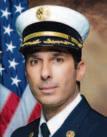
Chief McGlynn is a graduate of both the Emergency Ser vices Leadership Institute (ESLI) of the Florida Fire Chief’ s and the Fire Ser vice Executive Development Institute (FSEDI 11) of the IAFC. He also serves as an elected member of the Board of Directors for the Fire Chief’s Association of Palm Beach County. In addition, Doug serves as the Secretary for the Executive Leadership Development Section of the FFCA and is a Program Champion for FSEDI and ESLI.


By Vivian Shedd, Fire Public Information Officer, Fire Rescue, City of Tampa
In 2024, Tampa Fire Rescue welcomed 38 new firefighters into the department. Their graduation followed a grueling eight-week orientation, filled with live fire training, high-rise structure, and water rescues, along with classroom training. Congratulations to all.

By Jenn Samsel on behalf of Eric Proswimmer, Captain PIO Jacksonville Fire Rescue Department
The Guns and Hoses Hockey Charity Event was an intense showdown, with the Guns emerging victorious against the Hoses. Afterward, the Jacksonville Iceman faced off against the Savannah Ghost Pirates. It was a thrilling night filled with action on the ice, all for a great cause.
The Guns and Hoses Charity Hockey Tournament occurred at the Vystar Veterans Memorial Arena in Jacksonville.
Guns and Hoses began in 2015 at the old community’s first igloo, eventually leading to massive success and continual growth. The Jacksonville Iceman asked them to join their area in their third year. This year marks a significant milestone—the 10th anniversary of the Guns and Hoses Hockey Charity Event.


The game was a tight race that led to a sudden playoff match. Ultimately, the police won, with a final score of Guns six and Hoses five. Both teams played very well.
“It was a great game, great crowd. I mean, as you could see, these guys put everything into it. There’s a lot of behind-the-scenes stuff, but it’s wonderful. I appreciate all the support and all the fans. It’s been wonderful, and we hope to make it even bigger and better next year”, said Tommy Romano, Guns and Hoses Hockey Head Coach and Coordinator.
“I thought everyone battled really hard. It’s a fun game for us. We work alongside the police out in the streets. We see them every day. There are a lot of familiar faces. We see them at the rink. I told the guys to let it sting and then, for





10 minutes, forget about it. We’ve got a whole year to think about it. So we’ll get back into it, get back into practice, and we do a couple of tournaments a year,” said Patrick Bowen, Fire Hockey Team Captain and Jacksonville Fire Department Engineer.
“Both teams played a hard-fought hockey game for three periods. Each team held multiple practices for the last several months in preparation for the Guns and Hoses Hockey event. The game went back and forth throughout, but we were able to come out on top in overtime. Both teams respect each other and leave everything on the ice. We all look forward to this event every year and it is an honor being the captain of the Guns team, said Jason Robert.
The proceeds from the Hockey event went to the Jacksonville Firefighters Charities.

The Melrose Fire Department launched its new community Life Vest program in Melrose, FL, at the heart of Alachua County. This important initiative is designed to significantly enhance safety and elevate water safety awareness within the community. At the scene, a group of kids participated
while firefighters took the lead in demonstrating safety procedures. They carefully assisted each child in putting on brightly colored life vests, ensuring a snug fit for maximum safety.
The firefighters emphasized the critical importance of the vests and provided thorough

instructions on their proper use. The kids listened attentively as they practiced buckling the straps and mastering the techniques for floating effectively
"Today we're are putting out our Life Jacket Loaner Program Stand that we got through the Sea Tow Foundation at the Melrose Bay Park to
serve individuals in our community in our waterways," said Joshua Florence, PIO Firefighter, EMT, Melrose Fire Department
"We started the program because we've had multiple water-related fatalities in our area and are helping with our water rescue team. We found that if we have items available for individuals to use before they even need to call us, we can help the community even more by
reducing drowning risk. We plan on having more of these loaner life vests through all the water areas," he said
The loaner life vest stand at Melrose Bay Park is available for the community and is specifically designed for boaters. Boaters are encouraged to take a life vest from the stand, use it while on the water, and return it once they're done. This system ensures easy access a life vest as needed.
According to Florence, "87 percent of all

drownings were from individuals that were not wearing a life vest. Something like this can significantly reduce the risk and help us all have a safe summer and time out on the water."
"I fully support the program and the work that has been put into this program and hope it benefits the community in saving lives," said Chief Mobley,
Sarasota County: A Heart Safe Community Leading the Way in Cardiac Emergency Response and Public Education
In recognition of life-saving efforts and a multi-faceted public education program, the Sarasota County Fire Department (SCFD) was recently honored with the Heart Safe Community Award for a Large Community by the International Association of Fire Chiefs (IAFC).
The award, presented during the Fire-Rescue Med Conference, recognizes communities whose EMS systems have demonstrated excellence in improving outcomes for sudden cardiac arrest and acute coronary syndrome patients. SCFD earned the distinction following a review of agencies from across the world.
In Fiscal Year 2024, bystanders in Sarasota County per formed CPR in 46.3% of cardiac arrest cases, well above both state and national averages. The department also achieved a 32.6% resumption of sustained heart rhythm, a 27.7% overall survival rate to hospital discharge, and an 8.3% overall survival to baseline neurological status.
SCFD has submitted data to the Cardiac Arrest Registry for Enhanced Survival (CARES) since June 2022. This registry compares agencies at both the state and national levels and is becoming the standard of reporting cardiac arrest data.
Behind these achievements is a focused effort on community risk reduction. In partnership with the Sarasota County School Board, SCFD trained 2,737 public high school students in hands-only CPR and Automated External Defibrillator (AED) use in 2024. The training is also offered to local businesses and neighborhood associations, reaching 347 residents last year, further increasing the number of people prepared to act in an emergency. SCFD also partners with local hospitals to offer hands-only CPR demonstrations at fire station open houses, which are held monthly at various fire stations across the county.


“It’s not just about our
paramedics and firefighters showing up in time,” said David Rathbun, Sarasota County Fire Department Chief. “It’s vital to empower everyday people to be the first link in the chain of survival and utilize tools that can save lives.”
Utilizing the PulsePoint application and promoting it during these public education events, Sarasota County has 887 registered AEDs across the county and its municipalities. The PulsePoint app also alerts nearby users when a cardiac emergency is occurring in a public space.
SCFD is also recognized as a Mission: Lifeline Gold Target Heart Attack Honor Roll recipient by the American Heart Association for excellence in heart attack, stroke care and hospital collaboration in the improvement of patient outcomes. Last year marked the ninth consecutive year the department received the highest available American Heart Association Lifeline award. This is a testament to the medical direction from Dr. Marshall A. Frank, whose progressive, evidence-based heart attack protocols, including pre-hospital EKG transmission, help decrease time to definitive care and the daily dedication of SCFD paramedics and EMTs.
These awards highlight not only SCFD’s excellence in emergency care but also the department’s commitment to making Sarasota
County a safe place to live, work and play.
Sarasota County Fire Department first metrosized department in Florida to achieve GoldTier Recognition for Pediatric Emergency Readiness
The Sarasota County Fire Department (SCFD) is the first metro-sized department in Florida to earn Gold-Tier status in the Florida Prehospital Pediatric Readiness Recognition Program (PRRP). This recognition, awarded to only four EMS agencies statewide, underscores SCFD’s unwavering commitment to ensuring that its personnel are prepared to deliver the best possible care for any pediatric illness or injury.
This recognition not only acknowledges the department’s protocols and training but also reflects its proactive community outreach and focus on family-centered care.
Sarasota County Fire Department was one of the first agencies in the state to designate a prehospital Pediatric Emergency Care Champion (PECC). A prehospital PECC ensures pediatric clinical practice guidelines are followed, collaborates with local hospital PECCs, promotes pediatric training opportunities, and family-centered care.
SCFD takes a comprehensive approach to pediatric care. Every morning, crews verify that all pediatric equipment is accounted for during
truck checks to ensure the necessary tools are readily available for emergencies, making the care of young patients a seamless part of daily operations.
To maintain a high level of readiness, SCFD conducts pediatric/obstetrics and Handtevy mobile training integrated into both new hire orientation and the field training program for new paramedics. Changes to pediatric medications are updated in both a virtual platform and hard-copy protocols, to keep all personnel consistently updated on best practices.
To promote training and engagement within the department, crews competed to assemble the approved pediatric restraint device the fastest, the winner coming in at 43 seconds.
SCFD’s commitment to pediatric readiness extends beyond internal procedures. The department collaborates with the Sarasota County Sheriff’s Office (SSO) in active shooter drills, where simulations include both children and adults to prepare personnel for large-scale emergencies that could involve pediatric patients.
“Achieving Gold-Tier status is a significant accomplishment, but it’s only possible because of our collective dedication to continuous improvement in pediatric emergency care,” said Sarasota County Fire Chief David Rathbun.

“This recognition is a reflection of the hard work and commitment of our team.”
“Captain Jerry Rabish played an integral role in revamping the entire EMS protocol book to reflect pediatric delineations,” said Dr. Marshall Frank, Medical Director.
In addition to training, SCFD’s focus on community engagement and community risk reduction programs further solidifies its role in safeguarding children. Through the Stay Vigilant Initiative, SCFD partners with local agencies to share drowning prevention information. This initiative distributes free water watcher badges to the public and emphasizes the importance of supervision in and around bodies of water.
The department hosts monthly open houses that provide vital safety resources, such as bike helmet fittings and car seat installations. In the second half of 2024, SCFD’s outreach effort saw 382 bike helmets fitted and distributed, and the installation of 23 car seats, all while educating families on child safety.
One of the most impactful programs is SCFD’s hands-only CPR training. In Fiscal Year 2024, SCFD trained 2,737 Sarasota County high school students in hands-only CPR, with a special focus on child CPR and the proper use of automated external defibrillator(AEDs) in pediatric emergencies.


Bradford County Fire Rescue Unveils New Fire Engines with Historic Push-In Ceremony Honoring tradition and progress,Bradford County Fire Rescue proudly unveiled its two newest engines during a significant Engine Push-in Ceremony. This event was a day of high energy and celebration for all Bradford County Fire Rescue members, supported by County Commissioners and State Representatives.
The event occurred at the Speedville Fire Department in the Melrose, Bradford County community.
The ceremony proudly honored a vital fire service tradition rooted in the era of horsedrawn fire wagons. The symbolic washdown and push-in are potent reminders of our history and reaffirm our unwavering commitment to our mission and the community we serve.
Chief Carter opened the ceremony by welcoming everyone and expressing gratitude to the county commissioners and state representatives who contributed to implementing and funding the new fire
engines.
Neighboring fire stations were also present, including Fire Chief Kevin Mobley of the Melrose Fire Department and Fire Chiefs Darren and Matt Ferguson from Dixie County Fire Rescue, who attended to support the push-in engine ceremony.
"I want to begin by offering our sincere thanks to Representative Chuck Brannon, Senator Jennifer Bradley, and Lauren Tingle from the State Fire Marshal's office, who played an instrumental role in managing these appropriations and guiding the process at every step. These three individuals have been relentless advocates for public safety, and they

fought hard in Tallahassee to ensure Bradford County received the funding necessar y for these apparatuses. Their work in securing state appropriations made this possible, and we're truly grateful," said Fire Chief Carter, Bradford County Fire Rescue.
"These engines are an investment in the
See TRUCKS page 30

continued frompage 29
future of our department, the safety of our first responders, and the well-being of the people we serve, and They're among some of

the first fire engines in the state of Florida to be equipped with blue emergency lights in the rear," he said.

"We do appreciate the Fire Marshal's Office because when Senator Bradley and I are fortunate enough to secure and appropriate money, it has to be funneled through some of our state agencies. My prayer and hope is that they'll pump a lot of water over the years, put out a lot of fires, save structures, and save lives," said Representative Chuck Brannon.
Captain Kevin Mobley gave a brief history of the push-in and washdown ceremony tradition, which dates to the 17th century.
Before the washdown and push-in ceremony, Rev. Harry Hatcher blessed the servicemen, women, and engines.
Following the ceremony, the children and county commissioners acted by splashing small buckets of water onto the fire engines, symbolically washing them. Then, the crew members expertly backed the engine into the bay while the remaining members assisted in pushing in front of the vehicle.
Finally, a call was made to dispatch and confirm both engines were officially in service.
Final remark of Division Chief Rogers, "Thank everyone for coming today as we conclude today's push-in ceremony. This tradition honors not just a new piece of apparatus, but dedication, progress, and unity that define our department and the community we serve.”





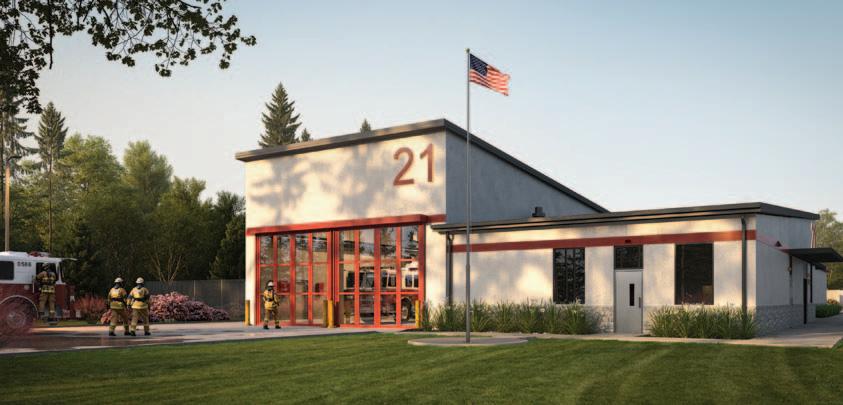
By Jenn Samsel - Independent Journalist on behalf of Chris Naff, PIO
St. Johns County officials proudly announced the groundbreaking of Fire Station 21, marking the official start of construction in partnership with the St. Johns Sheriff’s Office.
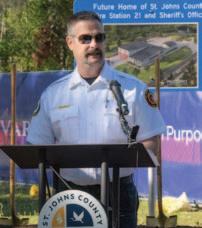
This new facility will be strategically situated in the Flagler Estates Community, directly serving the surrounding Hastings area in St. Johns County.
The estimated projected cost for the new facility is $3.8 million, designed to offer 6,036 square feet specifically for St. Johns County Fire Rescue. This facility will include one-and-a-half apparatus bays and provisions for four full-time personnel, ensuring that the needs of our community are met effectively St. Johns County Fire Chief Sean McGee stated, “We’re excited to begin this public safety building project in the heart of Flagler Estates. Today is a monumental day for Flagler Estates.”
St. Johns County Sheriff Robert Hardwick remarked, “We have heard nothing but requests to bring these ser vices to this community, and thanks to the county staff and county commissioners, we are doing just that. This project enhances our visibility in the community, not just for the St. Johns County Sheriff’s Department, but also highlights the special partnership we share with the Putnam County Sheriff’s Office and strengthens our cooperation with St. Johns County Fire Rescue. We cannot achieve our goals without your support.”
St. Johns County Board of County Commissioners Chair Krista Joseph added, “This joint facility will improve emergency response times and equip our firefighters and law enforcement officers with the tools they need to effectively perform their duties.”
Construction is expected to be completed by the end of 2025.
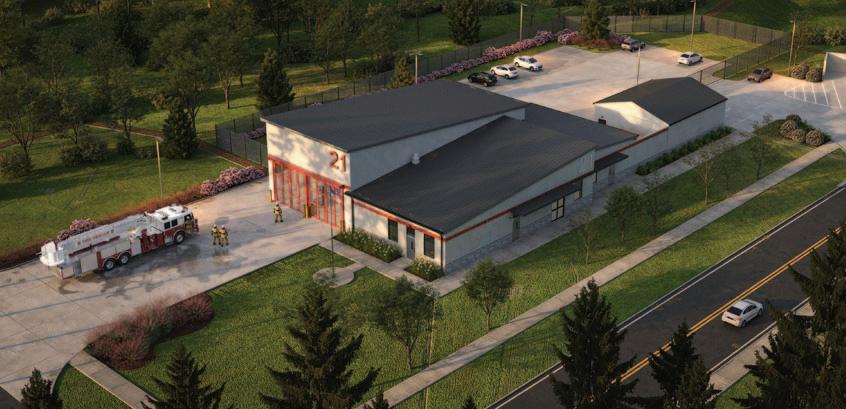
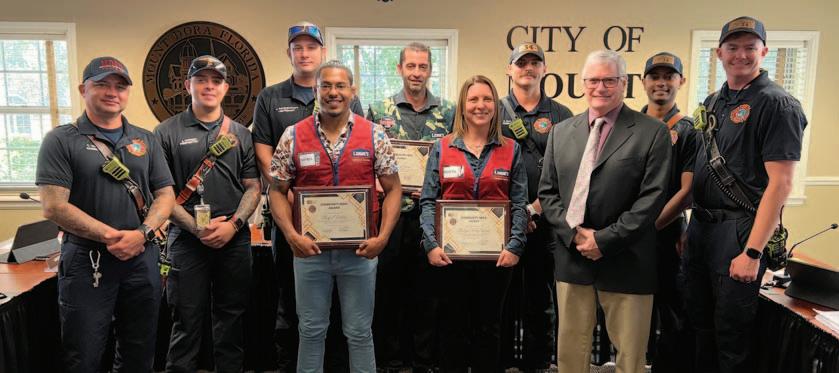
By Misty E. Sommer, Director of Economic Development, PIO
On Monday, April 7, 2025, the Mount Dora Fire Department responded to a cardiac arrest emergency at Lowe’s Home Improvement on US Highway 441. Thanks to the swift and heroic actions of Lowe’s employees, a life was saved before first responders arrived on the scene.
According to store staff, the patient had been alert and speaking with a cashier moments before collapsing, unresponsive and without a pulse. Without hesitation, Lowe’s employee Robyn McDonald retrieved the store’s Automated External Defibrillator (AED) while Jimmy Givens and Rafael Valdez initiated CPR. The team successfully delivered four AED shocks, resuscitating the patient prior to the arrival of emergency personnel.
Mount Dora Fire Department and Lake County Fire Rescue provided advanced post-cardiac arrest care and transported the patient to a local hospital.
On May 20, 2025, the Mount Dora City Council, in partnership with the Mount Dora Fire Department, recognized McDonald, Givens, and Valdez with Community Hero Awards for their decisive and life-saving actions.
“Had these individuals not acted so quickly and effectively, the outcome would have likely been much different,” said Fire Chief Hightower. “This incident is a power ful reminder of the critical importance of community education programs, including CPR, AED usage, and emergency response training.”
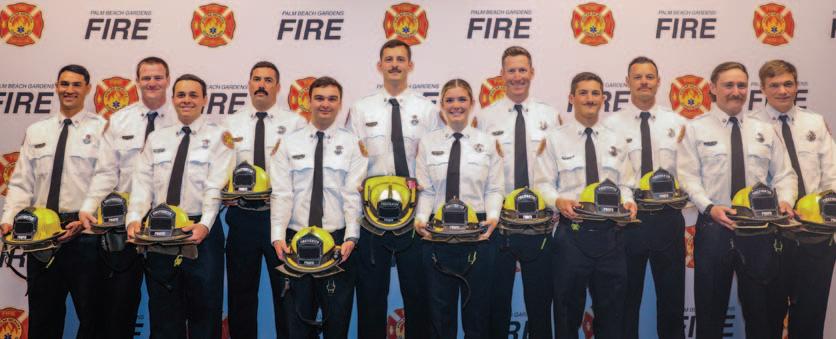
By Cory Bessette, Assistant Chief- Administration
Palm Beach Gardens Fire Rescue recently celebrated a significant milestone in the careers of its twelve newest firefighters with an Orange to Black ceremony. The event concluded with the firefighters taking their oaths of office, pledging their commitment to protect and serve the residents and visitors of the City of Palm Beach Gardens. In keeping with tradition, each firefighter replaced their probationary orange helmet shield with a black one—marking their official transition to full-fledged members of the department.


By Patrick Juliano, Fire Lieutenant/Paramedic, Palm Coast Fire Department
The Palm Coast Fire Department held a three-day joint training exercise with the Flagler County Sheriff’s Office – the latest in a long line of training efforts that the two agencies have worked together on to prepare for a variety of different emergencies.
Held at the Long Creek Nature Preserve, the exercise saw the two agencies responding to simulated emergency calls in which a victim of a jet skiing accident needed serious medical attention. Each scenario incorporated the use of one of five boats provided by the Flagler County Sheriff’s Office, who worked collaboratively with the Fire Department to engage, stabilize and transport the patient safely back to shore abord the vessel so that emergency medical procedures could be implemented.
“Emergencies can have complex variables, and this training is one that really incorporates a number of those variables –from unpredictability, to performing under pressure in an unfamiliar environment,” said Lt. Dan Driscoll of the Palm Coast Fire

Department. “We want to thank our partners in the Flagler County Sheriff’s Office for conducting this training with us and working side-byside so that we can all be as prepared as possible for any emergency.”
The three-day span saw nearly 60 members of the Palm Coast Fire Department participate in the exercise.










































































